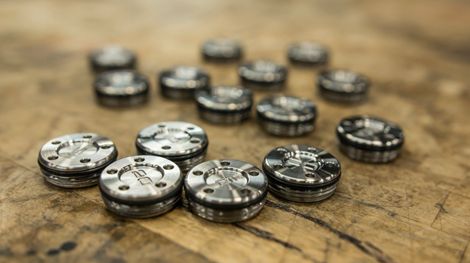Scotty Cameron Putter Selection Guide
The Art of Putting
A Modern Craftsman
Inside the Scotty Cameron Putter Studio in Southern California, my team and I are focused on one simple goal, producing the finest putters in the world.
Every day, we strive to learn more about how the ball, the putter and the golfer work together, and how we can improve that connection. Using state-of-the-art diagnostic tools, we gather information on how the world's best players approach putting. With those insights we continually experiment with new designs, materials and technologies.
This guide will help you select a putter to improve your performance on the green. The key elements of putter selection are length and toe flow, but all aspects of putter selection - including shape, weight, loft and lie are explained.
Whichever Scotty Cameron putter you choose, you can count on an unparalleled attention to detail that ensures complete harmony between how it looks, sounds, feels and performs.

Path
Putters Are Not Pendulums
Putters do not swing vertically back and through along the target line. Because of lie angle, the proper putting stroke moves along an arcing path: slightly inside of the target line, back to square, then to the inside again after impact.
The proper length putter correctly sets eye position just inside the target line, and the correct amount of toe flow allows the putter to flow squarely to the proper arcing path throughout the stroke.
Toe Flow
Everyone Needs Toe Flow
In order for the putter head to move squarely along the proper arcing path, the toe of the putter must "flow" throughout the stroke. How and where the neck or shaft of the putter joins the head determines its toe flow.
Be sure to choose a putter that either flows naturally along the proper arching path, or helps to correct it. This will reduce the tendency to manipulate the putter face with your hands. The best way to find the toe flow that corrects or complements your stroke is to hit straight, flat putts from 20 feet to see what works best.
Length
Length Sets Eye Position
If your putter is too long, your setup posture will be too upright with your eyes set too far inside the target line. If your putter is too short, your setup posture will be too hunched over with your eyes set too far outside the target line.
The ideal putter length sets your eyes 1-2" inside of the target line to allow you to execute the proper arcing putting stroke while maintaining good posture and balance.
Neck
Position Affects Performance
Neck design/position on a putter head affects putter performance. Shorter necks or shaft bends increase toe flow, resulting in a putter that swings more freely in an arc.
Longer necks or shaft bends decrease toe flow, supporting a less arcing stroke. Shaft axis closer to a putter's heel increases flow, while shaft axis closer to the center (like straight shafted putters) produces a face-balanced putter for a straighter, more mechanical stroke.
Grips
Complement the Design
A grip should complement the design of the putter. Smaller grips promote a more flowing, arcing stroke and generally pair well with higher toe flow putters. Larger grips promote a more “square to square” putting stroke and pair well with face balanced putters. Choose a grip that feels good in your hand and supports the design of your putter and your stroke type.
Loft, Lie & Weight
Loft & Lie
Scotty Cameron Putter Studio research shows that a ball pushes down slightly into the grass on a green, and that 3.5° of loft is needed to lift the ball up and on to the surface for a smooth roll.
The key to finding the proper lie angle is finding the correct putter length. Standard lie angle works for the vast majority of players if they have the correct length.

Weight
For most players, the standard Scotty Cameron weight configuration will produce the ideal balance and feel to execute the proper stroke. If your stroke tends to decelerate, if your hands get too active, or if you have too much wrist break, you should consider a putter that is heavier overall.

Explore Scotty Cameron Putters
Meticulously crafted from the finest materials, every Scotty Cameron putter is a work of art designed to perform at the highest level.
Scotty Cameron Putters Specifications
| Super Select |
RH/LH |
Lengths |
Loft |
Lie |
Neck |
Toe Flow | Offset |
Featured Grip |
|---|---|---|---|---|---|---|---|---|
| Newport | RH |
33", 34", 35" |
3.5° |
70° |
I-Beam Plumbing Neck | Medium | Full Shaft | Pistolini Plus |
| Newport + | RH |
33", 34", 35" |
3.5° |
70° |
I-Beam Plumbing Neck | Medium | Full Shaft | Pistolini Plus |
| Newport 2 | RH/LH |
33", 34", 35" |
3.5° |
70° |
I-Beam Plumbing Neck | Medium |
Full Shaft |
Pistolini Plus |
| Newport 2+ | RH |
33", 34", 35" |
3.5° |
70° |
I-Beam Plumbing Neck | Medium |
Full Shaft |
Pistolini Plus |
| Newport 2.5+ | RH/LH |
33", 34", 35" |
3.5° |
70° |
I-Beam Jet Neck | Near Maximum | 3/4 Shaft | Pistolini Plus |
| Squareback 2 | RH |
33", 34", 35" |
3.5° |
70° |
I-Beam Plumbing Neck | Medium |
3/4 Shaft |
Pistolero Plus |
| Squareback 2 Long Design | RH |
38" |
3.5° |
70° |
I-Beam Plumbing Neck | Medium |
3/4 Shaft |
Long Design* |
| Del Mar |
RH/LH |
33", 34", 35" |
3.5° |
70° |
Flow Neck |
Mid-High | 3/4 Shaft |
Pistolero Plus |
| Fastback 1.5 |
RH |
33", 34", 35" |
3.5° |
70° |
I-Beam Jet Neck | Near Maximum |
3/4 Shaft |
Pistolero Plus |
| GOLO 6 | RH |
33", 34", 35" |
3.5° |
70° |
Mid Bend Shaft |
Near Minimum |
Full Shaft |
Pistolero Plus |
| GOLO 6.5 | RH/LH |
33", 34", 35" |
3.5° |
70° |
I-Beam Jet Neck | Near Maximum |
3/4 Shaft |
Pistolero Plus |
| Phantom |
RH/LH |
Lengths |
Loft |
Lie |
Neck |
Toe Flow | Offset |
Featured Grip |
|---|---|---|---|---|---|---|---|---|
| Phantom 5 |
RH |
33", 34", 35" |
3.5° |
70° |
Mid Single Bend |
Minimum |
Full Shaft |
Full Contact |
| Phantom 5.5 |
RH |
33", 34", 35" |
3.5° |
70° |
I-Beam Jet |
Near Minimum |
3/4 Shaft |
Full Contact |
| Phantom 5s |
RH |
33", 34", 35" |
3.5° |
70° |
Straight Shaft | Minimum | Zero | Full Contact |
| Phantom 7 |
RH |
33", 34", 35" |
3.5° |
70° |
Mid Single Bend |
Minimum |
Full Shaft |
Full Contact |
| Phantom 7.5 |
RH/LH |
33", 34", 35" |
3.5° |
70° |
I-Beam Jet |
Near Minimum |
3/4 Shaft |
Full Contact |
| Phantom 9 |
RH |
33", 34", 35" |
3.5° |
70° |
Mid Single Bend | Minimum |
Full Shaft |
Full Contact |
| Phantom 9.5 |
RH |
33", 34", 35" |
3.5° |
70° |
I-Beam Jet |
Near Minimum |
3/4 Shaft |
Full Contact |
| Phantom 11 |
RH |
33", 34", 35" |
3.5° |
70° |
Mid Single Bend | Minimum |
Full Shaft |
Full Contact |
| Phantom 11.5 |
RH/LH |
33", 34", 35" |
3.5° |
70° |
Low Single Bend | Near Minimum |
3/4 Shaft |
Full Contact |
| Phantom 11 Long Design |
RH |
38" |
3.5° |
70° |
Mid Single Bend | Minimum |
Full Shaft |
Long Design* |
*The only grip available for the Phantom 11 Long Design is the 17-inch Long Design custom grip.